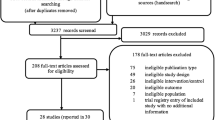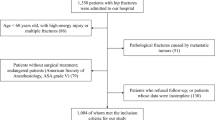Abstract
Cardiac troponins can be elevated in cardiac ischemic conditions or other diseases such as pulmonary embolism or renal failure, where they may predict outcome. We hypothesized that cardiac troponins offer useful prognostic information regarding morbidity and mortality in elderly hip fracture patients undergoing surgical therapy. A literature review was conducted using PubMed and CINAHL plus with full text (EBSCOhost). Articles with original data relating troponins to prognosis in elderly hip fracture patients were reviewed. Studies with patients not undergoing surgery or undergoing elective or nonhip fracture surgery were excluded. Six papers met inclusion criteria. Troponin elevation was seen in 26.7–39 % of patients, while myocardial infarction, cardiac complications, and cardiac death occurred in ≤35 % troponin-positive patients in four of six studies. Several noncardiac factors were associated with elevated troponin including higher American Society of Anaesthesiologists score, current smoking, reduced mobility/activity level, lower hemoglobin, and living in residential care. Patients with elevated troponin had longer lengths of stay, increased risk for discharge to long-term care facilities, and higher mortality. Increased age, male sex, and higher American Society of Anaesthesiologists score were also associated with mortality. Elevated troponin can be used as a marker of increased morbidity/mortality in elderly hip fracture patients undergoing surgery, as hypothesized, even in the absence of cardiac complications. Perioperative troponin evaluation may be useful for risk stratification, but further studies are needed to clarify risks and benefits of such testing.
Similar content being viewed by others
References
National Center for Health Statistics (2006) Trends in health and aging. US Department of Health and Human Services.
Gullberg B, Johnell O, Kanis JA (1997) World-wide projections for hip fracture. Osteoporos Int 7:407
Johnell O, Kanis JA (2004) An estimate of the worldwide prevalence, mortality and disability associated with hip fracture. Osteoporos Int 15:897–902
Shiga T, Wajima Z, Ohe Y (2008) Is operative delay associated with increased mortality of hip fracture patients? Systemic review, meta-analysis, and meta-regression. Can J Anaest 55:146–154
Goldacre MJ, Roberts SE, Yeates D (2002) Mortality after admission to hospital with fractured neck femur: database study. BMJ 325:868–869
Bhattacharyya T, Iorio R, Healy WL (2002) Rate of and risk factors for acute inpatient mortality after orthopaedic surgery. J Bone Joint Surg Am 84-A(4):562–572
Weatherall M (1994) One year follow up of patients with fracture of the proximal femur. N Z Med J 107:308–309
Ammann P, Pfisterer M, Fehr T, Rickli H (2004) Raised cardiac troponins: causes extend beyond acute coronary syndromes. BMJ 328:1028–1029
De Gennaro L, Brunetti ND, Cuculo A, Pellegrino PL, Izzo P, Roma F, Di Biase M (2008) Increased troponin levels in nonischemic cardiac conditions and noncardiac diseases. J Intervent Cardiol 21:129–139
Fisher AA, Southcott EN, Goh SL, Srikusalanukul W, Hickman PE, Davis MW, Potter JM, Budge MM, Smith PN (2008) Elevated serum cardiac troponin I in older patients with hip fracture: incidence and prognostic significance. Arch Orthop Trauma Surg 128:1073–1079
Izhaki A, Slesarenko Y, Boaz M, Haimovich Y, Rosenman Y (2011) Cardiac troponin T: an important predictor of late death and myocardial infarction following hip fracture: an eight-year prospective observational cohort study. Eur J Orthop Surg Traumatol 21:243–249
Spurrier E, Wordsworth D, Martin S, Norris R, Parker MJ (2011) Troponin T in hip fracture patients: prognostic significance for mortality at one year. Hip Int 21(6):757–761
Dawson-Bowling S, Chettiar K, Cottam H, Worth R, Forder J, Fitzgerald-O’Connor I, Walker D, Apthorp H (2008) Troponin T as a predictive marker of morbidity in patients with fractured neck of femur. Injury 39:775–780
Ausset S, Minville V, Marquis C, Fourcade O, Rosencher N, Benhamou D, Auroy Y (2009) Postoperative myocardial damages after hip fracture repair are frequent and associated with a poor cardiac outcome: a three-hospital study. Age Ageing 38(4):473–476
Talsnes O, Hjelmstedt F, Dahl OE, Reikeras O (2011) Clinical and biochemical prediction of early fatal outcome following hip fracture in elderly. Int Orthop 35:903–907
Ammann P, Fehr T, Minder E, Günter C, Bertel O (2001) Elevation of troponin I in sepsis and septic shock. Intensive Care Med 27:965–969
Ausset S, Auroy Y, Verret C, Benhamou D, Vest P, Cirodde A, Lenoir B (2010) Quality of postoperative care after major orthopedic surgery is correlated with both long-term cardiovascular outcome and troponin Ic elevation. Anesthesiology 113:529–540
Simunovic N, Devereaux PJ, Sprague S, Guyatt GH, Schemitsch E, DeBeer J, Bhandari M (2010) Effect of early surgery after hip fracture on mortality and complications: systematic review and meta-analysis. CMAJ 182(15):1609–1616
Pioli G, Lauretani F, Davoli ML, Martini E, Frondini C, Pellicciotti F, Zagatti A, Giordano A, Pedriali I, Nardelli A, Zurlo A, Ferrari A, Lunardelli ML (2012) Older people with hip fracture and IADL disability require earlier surgery. J Gerontol A Biol Sci Med Sci. doi:10.1093/gerona/gls097
Geraci SA (2012) Canary in the coal mine: cardiac troponins in non-coronary diseases. Am J Med 125(6):527–528
Conflicts of interest
None.
Author information
Authors and Affiliations
Corresponding author
Rights and permissions
About this article
Cite this article
Sandhu, A., Sanders, S. & Geraci, S.A. Prognostic value of cardiac troponins in elderly patients with hip fracture—a systematic review. Osteoporos Int 24, 1145–1149 (2013). https://doi.org/10.1007/s00198-012-2116-5
Received:
Accepted:
Published:
Issue Date:
DOI: https://doi.org/10.1007/s00198-012-2116-5




